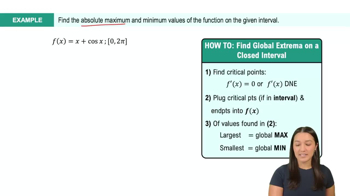Table of contents
- 0. Functions7h 52m
- Introduction to Functions16m
- Piecewise Functions10m
- Properties of Functions9m
- Common Functions1h 8m
- Transformations5m
- Combining Functions27m
- Exponent rules32m
- Exponential Functions28m
- Logarithmic Functions24m
- Properties of Logarithms34m
- Exponential & Logarithmic Equations35m
- Introduction to Trigonometric Functions38m
- Graphs of Trigonometric Functions44m
- Trigonometric Identities47m
- Inverse Trigonometric Functions48m
- 1. Limits and Continuity2h 2m
- 2. Intro to Derivatives1h 33m
- 3. Techniques of Differentiation3h 18m
- 4. Applications of Derivatives2h 38m
- 5. Graphical Applications of Derivatives6h 2m
- 6. Derivatives of Inverse, Exponential, & Logarithmic Functions2h 37m
- 7. Antiderivatives & Indefinite Integrals1h 26m
- 8. Definite Integrals3h 25m
5. Graphical Applications of Derivatives
Finding Global Extrema
Problem 61d
Textbook Question
The figure shows six containers, each of which is filled from the top. Assume water is poured into the containers at a constant rate and each container is filled in 10 s. Assume also that the horizontal cross sections of the containers are always circles. Let h (t) be the depth of water in the container at time t, for 0 ≤ t ≤ 10 . <IMAGE>
d. For each container, where does h' (the derivative of h ) have an absolute maximum on [0 , 10]?
 Verified step by step guidance
Verified step by step guidance1
Understand that h(t) represents the depth of water in the container as a function of time, and since the containers are filled at a constant rate, h'(t) will represent the rate of change of depth with respect to time.
Recognize that since the containers are filled uniformly over a period of 10 seconds, h(t) will be a linear function during this interval, which means h'(t) will be constant.
Identify that the absolute maximum of h'(t) on the interval [0, 10] will occur at the endpoints of the interval or where the function changes behavior, but since h'(t) is constant, we will evaluate it at the endpoints.
Evaluate h'(0) and h'(10) to determine the value of the derivative at the start and end of the filling process, noting that h'(t) will be the same throughout the interval.
Conclude that since h'(t) is constant, the absolute maximum occurs at both endpoints, and you can express this as h'(0) = h'(10), confirming that the maximum value is the same at both times.
Recommended similar problem, with video answer:
 Verified Solution
Verified SolutionThis video solution was recommended by our tutors as helpful for the problem above
Video duration:
4mPlay a video:
Was this helpful?
Related Videos
Related Practice










